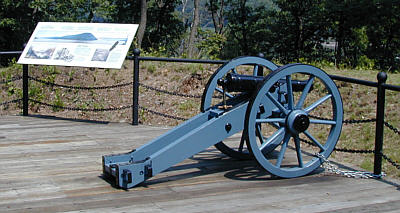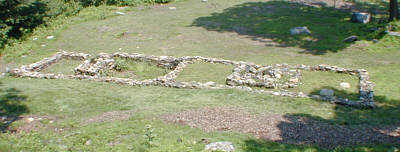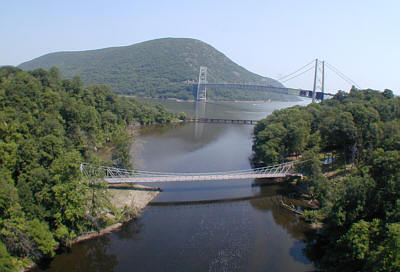FORT MONTGOMERYNEW YORK |
 |
FORT MONTGOMERYNEW YORK |
 |

In the late summer and fall of 1777, Sir Henry Clinton, who was in command of the British Forces in New York City, was expected to move north and participate in a three prong attack on Albany: Burgoyne from the north, St. Leger from the west and Clinton from the south. However, Howe left the decision to move north up to Clinton’s own discretion. His instructions were for Clinton to aid Burgoyne “if the circumstances warranted.” Instead, Clinton decided not to move his forces against Albany but to create a diversion that extended little further than Kingston, about 40 miles south of Albany.
|
|
|
The Naval Battle of Fort Montgomery When Sir Henry Clinton’s British troops reached Forts Clinton and Montgomery on October 6, 1777, some of his ships began moving upriver to support them. First came two galleys, the Dependence and the Crime, which were rowed into position. Four American ships, the frigate Montgomery, the sloop Camden, and the galleys Shark and Lady Washington defended the giant iron chain the Americans had stretched across the river below Fort Montgomery. As the British galleys approached, a fierce cannon battle ensued. The Dependence fired 95 shots from its 24-pounders and many more from its smaller 6-pounders, striking Fort Clinton and the American ships. The American commander held his fire until his ship, the Montgomery, was struck. He then returned the fire and ordered the massive 32-pounder cannon on board the Lady Washington to do the same. The guns from both forts fired on the British galleys too. Just before the battle reached its climax, two larger British ships, the brig Diligent and the sloop tender Hotham, and another galley, the Spitfire, came into view. Sir Henry Clinton later wrote that the sight of these ships “crowding all sail to support” the attack convinced him to begin his final assault. At dusk, the British drove the Americans from the forts, and the American vessels turned to support their fleeing soldiers. The Montgomery saved many Americans from capture by using its cannons to keep the British from encircling the fort. The Shark, the Camden, and the Lady Washington were ordered to rescue as many Americans as possible. As night fell, the ships tried to escape upriver, but the winds were not strong enough to overcome the ebb tide carrying them downriver. The Camden was run aground by its crew and was captured by the British. The Montgomery and the Shark were burned by their crews before they could fall into enemy hands. Only the Lady Washington escaped upriver. (Fort Montgomery Marker) |
In October, he moved up the east side of the Hudson and crossed to the west side at Stony Point. With a force of about 3,000, he moved north against the combined forces of about 600 Americans led by General George Clinton at Forts Clinton and Montgomery. The Americans held the forts until nightfall, but after losing almost half of their defenders, they withdrew.
|
|
|
You are looking at the foundation of a barracks built in the summer of 1776. This was probably a two-story building with a cellar under the northern half. Artifacts recovered from the site tell us a lot about the soldiers who lived here. In the 18th century, shoe buckles, brass and silver buttons, cuff links, glass tableware, tea services, and flatware were symbols of elevated social status. The large quantity of these items recovered from all of the barracks excavated at Fort Montgomery challenges traditional assumptions that these soldiers were poor and unsophisticated. An abundance of cattle, pig, sheep,
chicken, duck, pigeon, and fish bones was found in a large trash dump
just outside the building’s west wall, indicating that the soldiers
were generally well-supplied with meat. The animals were probably
butchered on site and the meat cooked in soups and stews that were eaten
from bowls using large pewter spoons. The scarcity of bones and other
debris inside the barracks suggests that the soldiers regularly cleaned
the building. (Fort Montgomery Marker) |
Today, the area where Fort Montgomery once stood has been cleared of brush and a walking path has been installed to tour the fort. There are several markers where the remains of the old fort have been uncovered.

It is difficult to see the strategic advantage of Fort Montgomery because most of the trees haven’t been cleared from the area as they were in 1777. However, a walk across the two bridges north and south of the fort on Route 9W clearly shows the control the fort had over the Hudson below. The walk is recommended and the view is spectacular.

|
Home of Isaac Garrison & Son, Revolutionary Cannoneers captured at the Battle of Fort Montgomery, 1777. (Route 9W Marker) |
|
